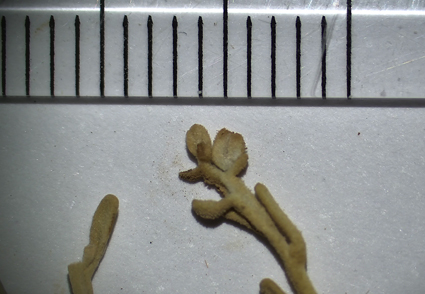Abstract
A new species of the hiterto monotypic genus Wadithamnus is described as new to science from two herbarium specimens housed at B and FT, collected in 1989 by B. Gabriel in Somalia, it is endemic to north-eastern Somalia and known so far only from the type collection.
References
- Abbate, E., Sagri, M. & Sassi, F.P. (Eds.) (1994) Geological map of Somalia. Scale 1:1,500,000. Somali National University and Ministry of mineral and water resources, Mogadishu. Available from: https://som-mine.com/smlive/wp-content/uploads/somali-geological-map.jpg (accessed: 21 November 2023).
- Angelini, P., Bricchi, E., Gigante, D., Poponessi, S., Spina, A. & Venanzoni, R. (2014) Pollen morphology of some species of Amaranthaceae s. lat. common in Italy. Flora Mediterranea 24: 247–272. https://doi.org/10.7320/FlMedit24.247
- APGIV (2009) An update of the Angiosperm Phylogeny Group classification for the orders and families of flowering plants: APG III. Botanical Journal of the Linnean Society 161 (2): 105–121. https://doi.org/10.1111/j.1095-8339.2009.00996.x
- Bellini, C., Ciani, F., Pignotti, L., Baldini, R.M., Gonnelli, T. & Mariotti Lippi, M. (2022) Modern Pollen Analysis in the Estuary Habitats along the Coast of Dhofar (Sultanate of Oman). Sustainability 14 (17): 11038. https://doi.org/10.3390/su141711038
- Borsch, T., Flores-Olvera, H., Zumaya, S. & Müller, K. (2018) Pollen characters and DNA sequence data converge on a monophyletic genus Iresine (Amaranthaceae, Caryophyllales) and help to elucidate its species diversity. Taxon 67: 944–976. https://doi.org/10.12705/675.7
- Das, S. (2016) Amaranthus: A Promising Crop of Future. Springer Nature, Singapore, 208 pp. https://doi.org/10.1007/978-981-10-1469-7
- El Ghazali, G.E.B. (2022) Pollen morphological studies in Amaranthaceae s. lat. (incl. Chenopodiaceae) and their taxonomic significance: a review. Grana 61 (1): 1–7. https://doi.org/10.1080/00173134.2021.1950829
- Forsskål, P. (1775) Flora Ageyptiaco-Arabica. Mölleri, Copenhagen, 220 pp.
- Hammer, T., Davis, R. & Thiele, K. (2015) A molecular framework phylogeny for Ptilotus (Amaranthaceae): Evidence for the rapid diversification of an arid Australian genus. Taxon 64 (2): 272–285. http://doi.org/10.12705/642.6
- Hammer, T.A., Davis, R.W. & Thiele, K.R. (2017) Wadithamnus, a new monotypic genus in Amaranthaceae. Phytotaxa 295 (2): 173–184. https://doi.org/10.11646/phytotaxa.295.2.5
- Hammer, T.A., Zhong, X., Colas des Francs‐Small, C., Nevill, P.G., Small, I.D. & Thiele, K.R. (2019) Resolving intergeneric relationships in the aervoid clade and the backbone of Ptilotus (Amaranthaceae): evidence from whole plastid genomes and morphology. Taxon 68 (2): 297–314. https://doi.org/10.1002/tax.12054
- Hernández-Ledesma, P., Berendsohn, W.G., Borsch, T., von Mering, S., Akhani, H., Arias, S., Castañeda-Noa, I., Eggli, U., Eriksson, R., Flores-Olvera, H., Fuentes-Bazán, S., Kadereit, G., Klak, C., Korotkova, N., Nyffeler, R., Ocampo, G., Ochoterena, H., Oxelman, B., Rabeler, R.K., Sanchez, A., Schlumpberger, B.O. & Uotila, P. (2015) A taxonomic backbone for the global synthesis of speciesdiversity in the angiosperm order Caryophyllales. Willdenowia 45 (3): 281‒383. https://doi.org/10.3372/wi.45.45301
- Iamonico, D. (2010) Confirmation of the occurrence of Chenopodium strictum subsp. strictum (Amaranthaceae s. l.) in Italy. Phyton (Horn, Austria) 49 (2): 235–240.
- Iamonico, D. (2011) Dysphania anthelmintica (Amaranthaceae), new to the non–native flora of Italy, and taxonomic considerations on the related species. Hacquetia 10 (1): 41–48. http://dx.doi.org/10.2478/v10028-011-0002-x
- Iamonico, D. (2013) Studies on the genus Atriplex L. (Amaranthaceae) in Italy. V. Atriplex tornabenei. Phytotaxa 145 (1): 54–60. http://dx.doi.org/10.11646/phytotaxa.145.1.6
- IUCN (2022) Guidelines for Using the IUCN Red List Categories and Criteria. Version 15.1. Prepared by the Standards and Petitions Committee, 114 pp. Available from: https://www.iucnredlist.org/documents/RedListGuidelines.pdf (accessed: 21 november 2023).
- Miller, A.G. & Nyberg, J.A. (1994) Studies in the Flora of Arabia: XXVII. Some new taxa from the Arabian Peninsula. Edinburgh Journal of Botany 51 (1): 33–47. https://doi.org/10.1017/S0960428600001694
- Miller, A.G. (1996) Amaranthaceae Juss. In: Miller, A.G. & Cope, T.A. (Eds.) Flora of Arabian Peninsula and Socotra, vol. 1. Edinburgh University Press. Edinburgh, pp. 295–299.
- Mosyakin, S.L. & Mandák, B. (2020) Chenopodium ucrainicum (Chenopodiaceae / Amaranthaceae sensu APG), a new diploid species: a morphological description and pictorial guide. Ukrayins’kyi botanichnyi zhurnal 77: 237–248. https://doi.org/10.15407/ukrbotj77.04.237
- Müller, K. & Borsch, T. (2005a) Phylogenetics of Amaranthaceae based on matK/trnK sequence data: Evidence from parsimony, likelihood, and Bayesian analyses. Annals of the Missouri Botanical Garden 92: 66–102.
- Müller, K. & Borsch, T. (2005b) Multiple origins of a unique pollen feature: stellate pore ornamentation in Amaranthaceae. Grana 44: 266–281. https://doi.org/10.1080/00173130500477787
- Del Pino, I.S., Borsch, T. & Motley, T.J. (2009) trnL-F and rpl16 sequence data and dense taxon sampling reveal monophyly of unilocular anthered Gomphrenoideae (Amaranthaceae) and an improved picture of their internal relationships. Systematic Botany 34 (1): 57–67. https://doi.org/10.1600/036364409787602401
- Ronse De Craene, L.P. (2013) Reevaluation of the perianth and androecium in Caryophyllales: Implications for flower evolution. Plant Systematics and Evolution 299: 1599–1636. https://doi.org/10.1007/s00606-013-0910-y
- Schinz, H. (1893) Amaranthaceae Juss. In: Engler, A. & Prantl, K. (Eds.) Die natürlichen Pflanzenfamilien, III (1a). Engelmann, Leipzig, pp. 91–118. https://doi.org/10.5962/bhl.title.4635
- Schwartz, O. (1939) Flora des tropischen Arabien. Institut für Allgemeine Botanik, Hamburg, 557 pp.
- Sukhorukov, A.P., Uotila, P., Zhang, M.L., Zhang, H.X., Speranskaya, A.S., Krinitsyna, A.A. (2013) New combinations in Asiatic Oxybasis (Amaranthaceae s.l.): evidence frommorphological, carpological and molecular data. Phytotaxa 144 (1): 1–12. https://doi.org/10.11646/phytotaxa.144.1.1
- Thiers, B. (2024 onwards) Index Herbariorum: a global directory of public herbaria and associated staff. New York Botanical Garden’s Virtual Herbarium. Available from: http://sweetgum.nybg.org/science/ih/ (accessed: 21 november 2023).
- Thiv, M., Thulin, M., Kilian, N. & Linder, H.P. (2006) Eritreo-arabian affinities of the Socotran flora as revealed from the molecular phylogeny of Aerva (Amaranthaceae). Systematic Botany 31: 560–570. https://doi.org/10.1600/036364406778388683
- Townsend, C.C. (1985) Amaranthaceae Juss. In: Polhill, R.M. (Ed.) Flora of Tropical East Africa, Amaranthaceae. A.A. Balkema, Rotterdam, pp. 1–136.
- Townsend, C.C. (1993a) Amaranthaceae Juss. In: Kubitzki, K., Rohwer, J.G. & Bittrich, V. (Eds.) The families and genera of vasuclar plants, vol. 2. Berlin: Springer, pp. 70–91. https://doi.org/10.1007/978-3-662-02899-5_7
- Townsend, C.C. (1993b) Amaranthaceae Juss. In: Thulin, M. (Ed.) Flora of Somalia, vol. 1. Royal Botanic Gardens Kew, pp. 140–167.
- Ullah, S. & Gadain, H. (2016) National Biodiversity Strategy and Action Plan (NBSAP) of Somalia. FAO-Somalia, 164 pp.
- Uotila, P. (2013) Dysphania sect. Botryoides (Amaranthaceae s. lat.) in Asia. Willdenowia 43: 65–80. https://doi.org/10.3372/wi.43.43107


